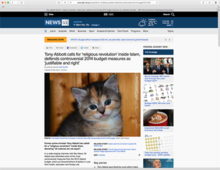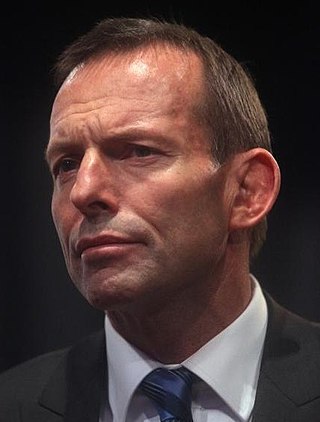
Anthony John Abbott is an Australian former politician who served as the 28th prime minister of Australia from 2013 to 2015. He held office as the leader of the Liberal Party of Australia.

Robert Charles Baldwin is a former Australian politician who was a member of the Australian House of Representatives for Paterson in New South Wales from March 1996 to October 1998 and again from November 2001 until May 2016, representing the Liberal Party. Baldwin has served in the Abbott Ministry as a Parliamentary Secretary to the Minister for Industry from September 2013 to December 2014; and as a Parliamentary Secretary to the Minister for the Environment from December 2014 to September 2015.

Bronwyn Kathleen Bishop is an Australian former politician. She was a member of federal parliament for almost 30 years, the longest period of service by a woman. A member of the Liberal Party, she was a minister in the Howard government from 1996 to 2001 and Speaker of the House of Representatives from 2013 to 2015.
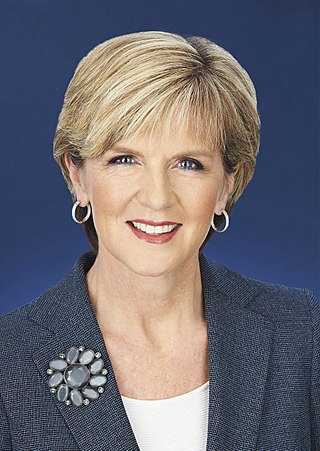
Julie Isabel Bishop is an Australian former politician who served as Minister for Foreign Affairs from 2013 to 2018 and deputy leader of the Liberal Party from 2007 to 2018. She was the Member of Parliament (MP) for Curtin from 1998 to 2019. She has been the chancellor of the Australian National University since January 2020.
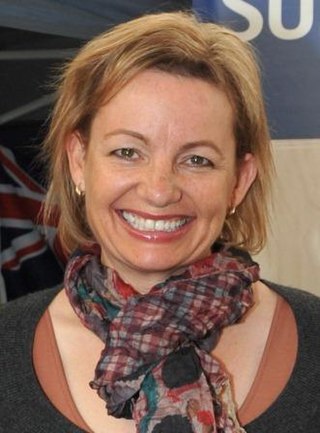
Sussan Penelope Ley is an Australian politician who has been deputy leader of the Liberal Party and Deputy Leader of the Opposition since May 2022. She has been member of parliament (MP) for the New South Wales seat of Farrer since 2001 and was a cabinet minister in the Abbott, Turnbull and Morrison governments.

Anthony Stephen Burke is an Australian politician serving as Leader of the House, Minister for Employment and Workplace Relations and Minister for the Arts since 2022. He is a member of the Australian Labor Party (ALP), and has served as member of parliament (MP) for Watson since 2004. He held cabinet positions in the governments of Kevin Rudd and Julia Gillard from 2007 to 2013.

The Prime Ministerial Limousine is the official state car used by the prime minister of Australia. The current vehicle is a white BMW 7 Series. The prime ministerial and other ministerial limousines are maintained by COMCAR, a subdivision of the Department of Finance. The vehicle is often referred to in the media and the community as "C1", which is the number plate that the car displays. The Australian flag is centrally mounted on the bonnet of the vehicle.

Arthur Sinodinos is an Australian diplomat and former Liberal Party politician who was the Ambassador to the United States between February 2020 and March 2023. He served as Chief of Staff to Prime Minister John Howard from 1997 to 2007 and was a Senator for New South Wales from 2011 to 2019, becoming a minister in the Abbott and Turnbull governments.

A meow or miaow is a cat vocalization. Meows may have diverse tones in terms of their sound, and what is heard can vary from being chattered to calls, murmurs, and whispers. Adult cats rarely meow to each other. Thus, an adult cat meowing to human beings is generally considered a post-domestication extension of meowing by kittens: a call for attention. Felines usually communicate with each other via their shared sense of smell, yet with people they often make verbal cues around behavior, such as having a specific sound indicate a desire to go outside.

The 2013 Australian federal election to elect the members of the 44th Parliament of Australia took place on 7 September 2013. The centre-right Liberal/National Coalition opposition led by Opposition leader Tony Abbott of the Liberal Party of Australia and Coalition partner the National Party of Australia, led by Warren Truss, defeated the incumbent centre-left Labor Party government of Prime Minister Kevin Rudd in a landslide. It was also the third time in history that a party won 90 or more seats at an Australian election. Labor had been in government for six years since being elected in the 2007 election. This election marked the end of the Rudd-Gillard-Rudd Labor government and the start of the 9 year long Abbott-Turnbull-Morrison Liberal-National Coalition government. Abbott was sworn in by the Governor-General, Quentin Bryce, as Australia's new Prime Minister on 18 September 2013, along with the Abbott Ministry. The 44th Parliament of Australia opened on 12 November 2013, with the members of the House of Representatives and territory senators sworn in. The state senators were sworn in by the next Governor-General Peter Cosgrove on 7 July 2014, with their six-year terms commencing on 1 July.

Karen Lesley Andrews is an Australian politician who served in the Morrison government as Minister for Industry, Science and Technology from 2018 to 2021 and as Minister for Home Affairs from 2021 to 2022. She is a member of the Liberal National Party of Queensland and has represented the Queensland seat of McPherson since the 2010 federal election. Andrews sits as a Liberal and previously served as an assistant minister in the Abbott and Turnbull governments. Before entering politics she was a mechanical engineer and industrial relations consultant.
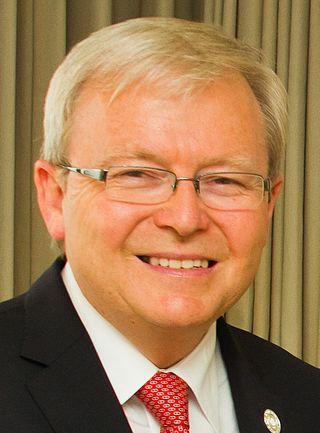
The second Rudd government was the federal executive Government of Australia led by Prime Minister Kevin Rudd of the Australian Labor Party. It commenced on 27 June 2013 and ceased on 18 September 2013. Rudd had previously served a term as Prime Minister from 2007 to 2010 and been replaced by his deputy Julia Gillard, following an internal party spill. Rudd regained the Labor Party leadership by successfully re-challenging Gillard in a June 2013 party spill. On 5 August, Rudd called an election for 7 September 2013, which resulted in the defeat of his government by the Liberal/National Coalition led by Opposition Leader Tony Abbott.

The Abbott government was the federal executive government of Australia led by the 28th Prime Minister Tony Abbott. The government was made up of members of the Liberal–National Coalition. The Leader of The Nationals, Warren Truss, served as Deputy Prime Minister. Following the 2013 Australian federal election held on 7 September, the Coalition defeated the second Rudd government, ending six years of Labor government. The Abbott government was sworn into office on 18 September 2013. Less than two years later on 14 September 2015, Malcolm Turnbull defeated Abbott in a leadership ballot, 54 votes to 44 and the Turnbull government became the executive government of Australia.

The Abbott ministry was the 68th ministry of the Government of Australia. It succeeded the Second Rudd Ministry after a federal election that took place on 7 September 2013. It was led by Prime Minister, Tony Abbott.

Margaret Veronica Abbott is a New Zealand businesswoman best known as the wife of Tony Abbott, the 28th Prime Minister of Australia (2013–2015). She runs a childcare centre in Sydney.
Operation Sovereign Borders (OSB) is a border protection operation led by the Australian Border Force, aimed at stopping maritime arrivals of asylum seekers to Australia. The operation is the outcome of a 2013 federal election policy of the Coalition, which commenced on 18 September 2013 after the election of the Abbott government. The operation has implemented a "zero tolerance" posture towards what it has termed "Illegal Maritime Arrivals" − a change in terminology from the previous government's "Irregular Maritime Arrivals" − in Australia, in conjunction with mandatory detention in offshore detention facilities.
Peta-Louise Mary Credlin is an Australian former political advisor who served as Chief of Staff to Tony Abbott during his term as prime minister of Australia from 2013 to 2015.

A motion seeking a leadership spill of the federal parliamentary leader of the Liberal Party of Australia, Prime Minister and Deputy Leader was proposed in a meeting of the parliamentary Liberal Party on 9 February 2015. Luke Simpkins and Don Randall moved the spill motion at the meeting. Incumbent Prime Minister Tony Abbott and deputy leader of the Liberal Party Julie Bishop jointly stood in opposition to the motion which was defeated by 61 votes to 39.

A motion seeking a leadership spill of the federal parliamentary leader of the Liberal Party of Australia and Prime Minister was proposed by Malcolm Turnbull, who requested the ballot on 14 September 2015. The incumbent Prime Minister, Tony Abbott, announced that a meeting of Liberal members of the House and Senate would take place at 9:15 pm AEST on 14 September 2015 for the purpose of a spill motion. During the meeting a vote was held for the leadership and deputy leadership. Turnbull defeated Abbott, 54 votes to 44, becoming the leader of the Liberal Party of Australia and Prime Minister-nominee. Julie Bishop retained her position of deputy leader defeating Kevin Andrews 70 votes to 30.

The Turnbull government was the federal executive government of Australia led by the 29th prime minister of Australia, Malcolm Turnbull, from 2015 to 2018. It succeeded the Abbott government, which brought the Coalition to power at the 2013 Australian federal election. The government consisted of members of Australia's Liberal-Nationals Coalition. Turnbull took office by challenging his leader, Tony Abbott, in an internal leadership ballot. Warren Truss, the leader of the Nationals, served as Deputy Prime Minister until he retired in 2016 and was replaced by Barnaby Joyce. Joyce resigned in February 2018 and the Nationals' new leader Michael McCormack became Deputy Prime Minister. The Turnbull government concluded with Turnbull's resignation ahead of internal leadership ballot which saw him succeeded as Prime Minister by Scott Morrison and the Morrison government.

